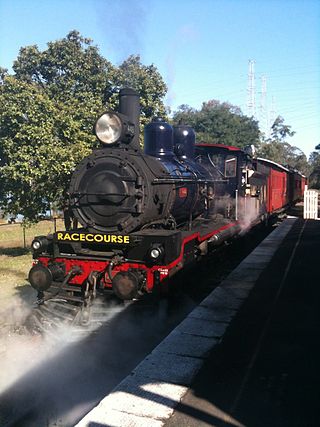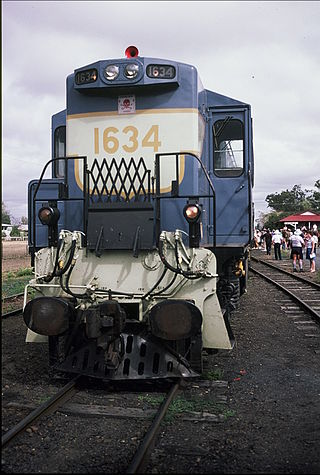| Queensland Railways C17 class | |||||||||||||||||||||||||||
|---|---|---|---|---|---|---|---|---|---|---|---|---|---|---|---|---|---|---|---|---|---|---|---|---|---|---|---|
 802 on the Mary Valley Heritage Railway | |||||||||||||||||||||||||||
| |||||||||||||||||||||||||||
| |||||||||||||||||||||||||||
| |||||||||||||||||||||||||||
| |||||||||||||||||||||||||||
The Queensland Railways C17 class locomotive are a class of 4-8-0 steam locomotives operated by the Queensland Railways.
| Queensland Railways C17 class | |||||||||||||||||||||||||||
|---|---|---|---|---|---|---|---|---|---|---|---|---|---|---|---|---|---|---|---|---|---|---|---|---|---|---|---|
 802 on the Mary Valley Heritage Railway | |||||||||||||||||||||||||||
| |||||||||||||||||||||||||||
| |||||||||||||||||||||||||||
| |||||||||||||||||||||||||||
| |||||||||||||||||||||||||||
The Queensland Railways C17 class locomotive are a class of 4-8-0 steam locomotives operated by the Queensland Railways.
The C17 class was introduced as an improved version of the C16 class. Per Queensland Railway's classification system they were designated the C17 class, C representing they had four driving axles, and 17 representing the cylinder diameter in inches.
The design was so successful that 227 locomotives were built from 1920 when the first engine Nº 15 entering service through until 1953 when Nº 1000 was delivered. The Commonwealth Railways NM class were of the same design. [1] [2] [3] [4]
They were used to haul Mail trains on lines could not accommodate heavier B18¼ class, also suburban passenger, mixed, goods and branch line trains. Until 1948 they were the heaviest engines that could work north of Mackay. Prior to the introduction of 60 long tons (67 short tons; 61 t) diesel electric locomotives, they were responsible for hauling the air-conditioned Inlander, Midlander and Westlander trains for parts of their respective journeys.
First engines had large steam domes, open cabs and C16 style tenders. Those built from 1938 onwards, commencing with N°858, had small steam domes, sedan cabs with welded tenders and also larger diameter (9+1⁄2 in or 241 mm) piston valves. The two types of boilers were occasionally interchanged at overhauls and by later years most of the old style ones had been replaced. The last 40 engines, Nº961 to Nº1000, were fitted with Timken roller bearings and painted brown. They acquired the nickname of Brown Bombers after American boxer Joe Louis. Those overhauled in the last years of steam operations were repainted black. A number of modifications were carried out over their life including the fitting of large mushroom air snifting valves. Several had additional sandboxes and/or rear headlights fitted at various times for working lines where no turning facilities were available. [1] [3]
On 5 May 1947, C17 class locomotive 824 left the rails near Camp Mountain on the Dayboro line claiming the lives of 16 people and 38 injured. The Commonwealth Department of Trade & Customs Recreation and Social Club had chartered the train for a picnic at Closeburn. Negotiating a sharp curve at excessive speed caused the tragedy. The locomotive was repaired and continued in service until May 1967 when it was transferred to Injune along the recently closed line.
Twenty-five have been preserved:

The Hunslet Engine Company is a locomotive building company, founded in 1864 in Hunslet, England. It manufactured steam locomotives for over 100 years and currently manufactures diesel shunting locomotives. The company owns a substantial fleet of Industrial and depot shunting locomotives which are available for hire. The company is part of Ed Murray & Sons Ltd.

Injune is a rural town and locality in the Maranoa Region, Queensland, Australia. In the 2016 census, the locality of Injune had a population of 461 people.

The Camp Mountain rail accident occurred at approximately 9:48 am on 5 May 1947 when a crowded picnic train derailed on a sharp left-hand curve between Ferny Grove and Camp Mountain stations on the now-closed Dayboro railway line, in the suburb of Camp Mountain approximately 15 km (9.3 mi) northwest of Brisbane, the state capital of Queensland, Australia.
Kitson and Company was a locomotive manufacturer based in Hunslet, Leeds, West Yorkshire, England.

The Mary Valley Rattler is a heritage railway line that conducts steam train trips and tours from Gympie through the Mary Valley using the former Mary Valley railway line in the Gympie Region, Queensland, Australia. It is now one of the region's biggest tourist attractions and is managed by a not-for-profit organisation. It has been described as Australia's third biggest heritage railway. It was shut down for safety reasons in 2012. In 2016, the Gympie Regional Council provided funding to make the railway operational again as it is a major tourist attraction for the area. Journeys recommenced between Gympie and Amamoor on 6 October 2018.

The K class was a branch line steam locomotive that ran on Victorian Railways in Australia from 1922 to 1979. Although its design was entirely conventional and its specifications unremarkable, the K class was in practice a remarkably versatile and dependable locomotive. It went on to outlast every other class of steam locomotive in regular service on the VR, and no fewer than 21 examples of the 53 originally built have survived into preservation.

The New South Wales D50 class was a class of 2-8-0 steam locomotives operated by the New South Wales Government Railways in Australia.

The WAGR W class is a class of 4-8-2 steam locomotives operated by the Western Australian Government Railways (WAGR) between 1951 and 1972.

The Queensland Railways PB15 class locomotive is an old class of 4-6-0 steam engines operated by the Queensland Railways.

The South Maitland Railways 10 Class locomotives is a class of 14 2-8-2T steam locomotives built for the East Greta Coal Company by Beyer, Peacock & Company in Manchester, England, between 1911 and 1925. Members of this class of locomotive were the last steam locomotives in commercial use in Australia.
The Queensland Pioneer Steam Railway is located near Ipswich, Queensland, Australia and runs through the former West Moreton pioneering coal fields. It was first opened in 1881 by colliery proprietor and politician Lewis Thomas (1832-1913) as a tramway to his coal mines.

The Queensland Railways AC16 class locomotive was a class of 2-8-2 steam locomotives operated by the Queensland Railways.
The Queensland Railways C16 class locomotive is a class of 4-8-0 steam locomotives that was operated by the Queensland Railways.

The Queensland Railways B12 class locomotive was a class of 2-6-0 steam locomotives operated by the Queensland Railways.

The Queensland Railways DD17 class locomotive was a class of 4-6-4T steam locomotives operated by the Queensland Railways. It is an improved version of the earlier Queensland D17 locomotive.

The Queensland Railways D17 class locomotive was a class of 4-6-4T steam locomotives operated by the Queensland Railways.

The Queensland Railways C19 class locomotive was a class of 4-8-0 steam locomotives operated by the Queensland Railways.

The WAGR G class is a class of steam locomotives operated by the Western Australian Government Railways (WAGR) from 1889. The class's wheel arrangement varied; 48 were 2-6-0s and 24 were 4-6-0s.

The WAGR A class was a class of 2-6-0 steam locomotives designed by Beyer, Peacock & Co and operated by the Western Australian Government Railways (WAGR) between 1881 and 1955.

The 1620 class was a class of diesel locomotives built by English Electric, Rocklea for Queensland Railways between 1967 and 1969.
![]() Media related to Queensland C17 class locomotives at Wikimedia Commons
Media related to Queensland C17 class locomotives at Wikimedia Commons